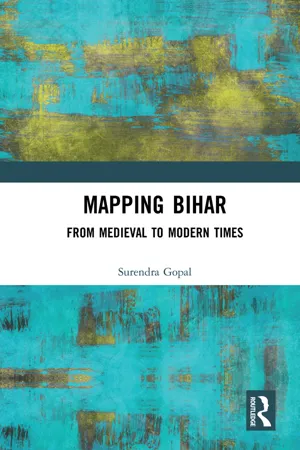
- 452 pages
- English
- ePUB (mobile friendly)
- Available on iOS & Android
About This Book
Written Indian history begins in sixth century bc with the history of Magadh (present day states of Jharkhand and Bihar). For almost a millennium Magadh dominated Indian history. The situation changed when Islamicized Turks entered India. The Mughals who followed the Turks ensured Bihar's economic prosperity; Patna became the most important centre of Himalayan trade. European Companies visited Patna to obtain a variety of goods, local as well as Himalayan. In the mid-eighteenth century Bihar and Bengal fell into the hands of Englishmen. A new chapter began.
At the turn of the nineteenth century, Industrial Revolution began in Britain.
The East India Company stopped trading in textiles. Instead, they promoted cotton cultivation in order that cotton was available to British textile factories. They promoted cultivation of indigo, needed by the textile manufacturing factories coming up. Land revenue source of the government's prime income, was collected even when agricultural output suffered massively. The government took deep interest in opium production but paid the cultivators less than the market price. British interference in agricultural matters caused wide spread agrarian distress.
Indian society encountered many socio-religious reform movements. Raja Rammohun Roy and Swami Dayanand were major proponents of the new order. Stress was laid on gender equality, women empowerment and the modern system of education. Institutions for training doctors, engineers and scientists were opened. As time progressed, by and large, Biharis accepted the changes. Eventually social reform movements turned into the freedom movement in which Biharis played a leading role.
This comprehensive volume is indispensable for scholars working on Bihar and modern and medieval South Asia.
Please note: Taylor & Francis does not sell or distribute the Hardback in India, Pakistan, Nepal, Bhutan, Bangladesh and Sri Lanka
Frequently asked questions
Table of contents
- Cover
- Half Title
- Title Page
- Copyright Page
- Dedication
- Table of Contents
- Preface
- 1. Ideas in Ancient and Medieval Bihar
- 2. Bihar Peasants in the Early Decades of the Eighteenth Century
- 3. Changing Bases of Peasant Movement in Bihar, 1917–1975
- 4. Peasant Movement in Bihar during the Second World War (Some Newspaper Sources)
- 5. Opium Raiyats in Bihar in the First Half of the Nineteenth Century
- 6. Revenue Roll Registers: An Aid for Quantitative Study of Agrarian History of Bihar in the Nineteenth Century
- 7. Beginnings of Peasant Protest against European Indigo Planters in Bihar
- 8. Small Towns in Bihar in the First Half of the Nineteenth Century (A Study in the Character of Urban Growth)
- 9. A New Pattern of Urban Growth: Emergence of Zamindari Towns in Bihar (A Case Study of Dumraon in the Second Half of the Nineteenth Century)
- 10. Endeavour and Persistence: Brahmo Samaj in Bihar in the Second Half of the Nineteenth Century
- 11. Swami Dayanand, Bihar and Arya Samaj
- 12. Dalits in Bihar: A Historical Study
- 13. The Roots of Conservatism and Casteism: A Study of Social Change in Bihar in the Second Half of the Nineteenth Century
- 14. An Elite Group in the Second Half of the Nineteenth Century in Bihar
- 15. Industrial Capitalism and Entrepreneurship in Bihar in the Nineteenth Century
- 16. Socio-Cultural Contours of Patna at the Turn of the Twentieth Century
- 17. European Accounts of Bihar in the Second Half of the Eighteenth Century
- 18. Bihar in the Eyes of British Travellers and Painters, 1780–1850
- 19. Aniruddha Ray on European Discourses on Bihar
- 20. Science College, Patna, 1927–1947
- 21. Munshi Binayak Prasad: A ‘Native’ History-writer
- Bibliography
- Index